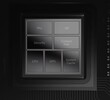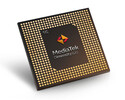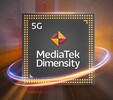Google Tensor vs MediaTek Dimensity 800 vs MediaTek Dimensity 6080
Google Tensor
► remove from comparison
The Google Tensor SoC (G1, first generation) is the first smartphone processor from Google. It is positioned as a high end SoC and focuses on the integrated TPU for efficient AI and ML calculations. The CPU part integrates two fast and big ARM Cortex X1 cores at up to 2.8 GHz. A second cluster integrates 2 mid range Cortex-A76 cores at up to 2.25 GHz. Finally, four small ARM Cortex-A55 cores with up to 1.8 GHz are integrated for efficiency purposes. All cores can access the shared 4 MB L3 cache.
The successors of the Tensor SoC are the Tensor G2 and G3.
The chip also integrates a Titan M2 security processor and a ARM Mali G78 MP20 GPU. The chip is manufactured in the modern 5nm process.
MediaTek Dimensity 800
► remove from comparison
The Mediatek Dimensity 800 is a fast mid-range SoC with an integrated 5G modem. It includes four fast ARM Cortex-A76 cores at up to 2 GHz and four power efficient Cortex-A55 cores at up to 2 GHz (Octa-Core with Heterogeneous Multi-Processing). Furthermore, the chip integrates a 4 core ARM Mali-G57 MC4 GPU, a Wi-fi 5 modem, a LPDDR4x memory controller(up to 16 GB with 2133 MHz), a AI processing unit (APU 3.0) and video de- and encoding.
Compared to the similar named Dimensity 800U, the 800 offers two more big A76 cores but clocked 400 MHz lower. This means the single core performance is lower, but the multi-core performance can be better.
The Dimensity 800 is manufactured in the modern 7nm process and should be very power efficient.
MediaTek Dimensity 6080
► remove from comparison
The MediaTek Dimensity 6080 (MT6833V/MT6833GP) is an ARM-based SoC (system-on-a-chip) manufactured by TSMC using the 6 nm process. It was specially designed for use in Android smartphones and is in the lower mid-range in terms of performance. It supports all current mobile communication standards, including 5G Sub6.
The SoC is identical to the MediaTek Dimensity 810 the only difference is that the Dimensity 6080 can cope with a camera resolution of up to 108 megapixels.
The CPU works with a total of eight cores, which are divided into two clusters. One has two ARM Cortex-A76 power cores with up to 2.4 GHz each, while the other has six ARM Cortex-A55 energy-saving cores with up to 2.0 GHz each. LPDDR4x RAM with 2,133 MHz can be used as RAM and UFS 2.2 is supported as internal memory.
In terms of connectivity, dual 5G (Sub6) with a theoretical peak download speed of up to 2.77 GBit/s is available, as well as Wi-Fi 5 and Bluetooth 5.1.
The integrated graphics unit ARM Mali-G57 MP2 can power displays with a resolution of up to 2,520 x 1,080 pixels (Full HD+) and a refresh rate of up to 120 Hz.
| Model | Google Tensor | MediaTek Dimensity 800 | MediaTek Dimensity 6080 | ||||||||||||
| Codename | Exynos X1 / Cortex-A76 / A55 | Cortex-A76 / A55 | Cortex-A76 / A55 | ||||||||||||
| Clock | 1800 - 2800 MHz | 2000 MHz | 2000 - 2400 MHz | ||||||||||||
| L3 Cache | 4 MB | ||||||||||||||
| Cores / Threads | 8 / 8 | 8 / 8 | 8 / 8 2 x 2.4 GHz ARM Cortex-A76 6 x 2.0 GHz ARM Cortex-A55 | ||||||||||||
| Technology | 5 nm | 7 nm | 6 nm | ||||||||||||
| Features | ARM Mali-G78MP20 GPU | 4x ARM Cortex-A76 (2 GHz), 4x ARM Cortex-A55 (2 GHz), ARM Mali-G75 MC5, APU 3.0, 5G Modem (2CC), MiraVision (4K HDR Video, 80MP Photo), Wi-Fi 5, Bluetooth 5.1, UFS 2.2, 16GB LPDDR4x Support | Wi-Fi 5 (1T1R Antenna), 5G Multi-Mode 2.77 Gbps Download, GNSS: GPS L1CA+L5, BeiDou B1I+ B2a, Glonass L1OF, Galileo E1 + E5a, QZSS L1CA+ L5, NavIC | ||||||||||||
| iGPU | ARM Mali-G78 MP20 ( - 848 MHz) | ARM Mali-G57 MP4 | ARM Mali-G57 MP2 | ||||||||||||
| Architecture | ARM | ARM | ARM | ||||||||||||
| Announced | |||||||||||||||
| Manufacturer | blog.google | www.mediatek.com | |||||||||||||
| Series | Mediatek Dimensity 6000 | ||||||||||||||
| Series: Dimensity 6000 Cortex-A76 / A55 |
|
Benchmarks
Average Benchmarks Google Tensor → 100% n=6
Average Benchmarks MediaTek Dimensity 800 → 64% n=6
Average Benchmarks MediaTek Dimensity 6080 → 69% n=6
* Smaller numbers mean a higher performance
1 This benchmark is not used for the average calculation












